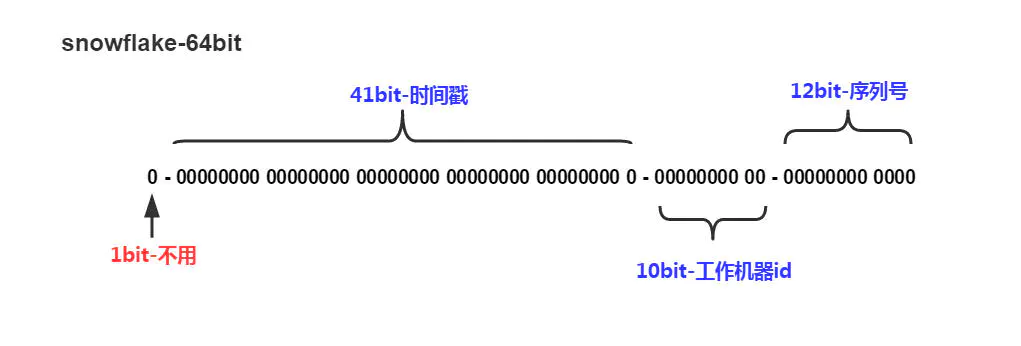雪花算法-Java分布式系统自增id
1、雪花算法的用途
分布式系统中ID生成方案,比较简单的是UUID(Universally Unique Identifier,通用唯一识别码),但是其存在两个明显的弊端:
一、UUID是128位的,长度过长;
二、UUID是完全随机的,无法生成递增有序的UUID。
而现在流行的基于 Snowflake 雪花算法的ID生成方案就可以很好的解决了UUID存在的这两个问题
2、算法原理

-
1bit,不用,因为二进制中最高位是符号位,1表示负数,0表示正数。生成的id一般都是用整数,所以最高位固定为0。
-
41bit-时间戳,用来记录时间戳,毫秒级。
- 41位可以表示个数字,
- 如果只用来表示正整数(计算机中正数包含0),可以表示的数值范围是:0 至,减1是因为可表示的数值范围是从0开始算的,而不是1。
- 也就是说41位可以表示个毫秒的值,转化成单位年则是
年
-
10bit-工作机器id,用来记录工作机器id。
- 可以部署在个节点,包括5位datacenterId和5位workerId
- 5位(bit)可以表示的最大正整数是,即可以用0、1、2、3、....31这32个数字,来表示不同的datecenterId或workerId
-
12bit-序列号,序列号,用来记录同毫秒内产生的不同id。
- 12位(bit)可以表示的最大正整数是,即可以用0、1、2、3、....4094这4095个数字,来表示同一机器同一时间截(毫秒)内产生的4095个ID序号。
3、Java 实现雪花算法
public class IdWorker{
//下面两个每个5位,加起来就是10位的工作机器id
private long workerId; //工作id
private long datacenterId; //数据id
//12位的序列号
private long sequence;
public IdWorker(long workerId, long datacenterId, long sequence){
// sanity check for workerId
if (workerId > maxWorkerId || workerId < 0) {
throw new IllegalArgumentException(String.format("worker Id can't be greater than %d or less than 0",maxWorkerId));
}
if (datacenterId > maxDatacenterId || datacenterId < 0) {
throw new IllegalArgumentException(String.format("datacenter Id can't be greater than %d or less than 0",maxDatacenterId));
}
System.out.printf("worker starting. timestamp left shift %d, datacenter id bits %d, worker id bits %d, sequence bits %d, workerid %d",
timestampLeftShift, datacenterIdBits, workerIdBits, sequenceBits, workerId);
this.workerId = workerId;
this.datacenterId = datacenterId;
this.sequence = sequence;
}
//初始时间戳
private long twepoch = 1288834974657L;
//长度为5位
private long workerIdBits = 5L;
private long datacenterIdBits = 5L;
//最大值
private long maxWorkerId = -1L ^ (-1L << workerIdBits);
private long maxDatacenterId = -1L ^ (-1L << datacenterIdBits);
//序列号id长度
private long sequenceBits = 12L;
//序列号最大值
private long sequenceMask = -1L ^ (-1L << sequenceBits);
//工作id需要左移的位数,12位
private long workerIdShift = sequenceBits;
//数据id需要左移位数 12+5=17位
private long datacenterIdShift = sequenceBits + workerIdBits;
//时间戳需要左移位数 12+5+5=22位
private long timestampLeftShift = sequenceBits + workerIdBits + datacenterIdBits;
//上次时间戳,初始值为负数
private long lastTimestamp = -1L;
public long getWorkerId(){
return workerId;
}
public long getDatacenterId(){
return datacenterId;
}
public long getTimestamp(){
return System.currentTimeMillis();
}
//下一个ID生成算法
public synchronized long nextId() {
long timestamp = timeGen();
//获取当前时间戳如果小于上次时间戳,则表示时间戳获取出现异常
if (timestamp < lastTimestamp) {
System.err.printf("clock is moving backwards. Rejecting requests until %d.", lastTimestamp);
throw new RuntimeException(String.format("Clock moved backwards. Refusing to generate id for %d milliseconds",
lastTimestamp - timestamp));
}
//获取当前时间戳如果等于上次时间戳(同一毫秒内),则在序列号加一;否则序列号赋值为0,从0开始。
if (lastTimestamp == timestamp) {
sequence = (sequence + 1) & sequenceMask;
if (sequence == 0) {
timestamp = tilNextMillis(lastTimestamp);
}
} else {
sequence = 0;
}
//将上次时间戳值刷新
lastTimestamp = timestamp;
/**
* 返回结果:
* (timestamp - twepoch) << timestampLeftShift) 表示将时间戳减去初始时间戳,再左移相应位数
* (datacenterId << datacenterIdShift) 表示将数据id左移相应位数
* (workerId << workerIdShift) 表示将工作id左移相应位数
* | 是按位或运算符,例如:x | y,只有当x,y都为0的时候结果才为0,其它情况结果都为1。
* 因为个部分只有相应位上的值有意义,其它位上都是0,所以将各部分的值进行 | 运算就能得到最终拼接好的id
*/
return ((timestamp - twepoch) << timestampLeftShift) |
(datacenterId << datacenterIdShift) |
(workerId << workerIdShift) |
sequence;
}
//获取时间戳,并与上次时间戳比较
private long tilNextMillis(long lastTimestamp) {
long timestamp = timeGen();
while (timestamp <= lastTimestamp) {
timestamp = timeGen();
}
return timestamp;
}
//获取系统时间戳
private long timeGen(){
return System.currentTimeMillis();
}
//---------------测试---------------
public static void main(String[] args) {
IdWorker worker = new IdWorker(1,1,1);
for (int i = 0; i < 30; i++) {
System.out.println(worker.nextId());
}
}
}



